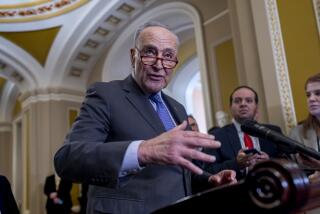Tyson Touts Clinton Plan to Congress : Recovery: She testifies that the U.S. may be headed for another stall if the President’s stimulus package is defeated.
- Share via
WASHINGTON — The economic recovery may “stall again” if Congress balks at approving President Clinton’s $30-billion stimulus package this spring, chief White House economist Laura D’Andrea Tyson warned Monday.
Despite some improvement in the economy, Tyson said, there are persistent signs of weakness and very slow growth in employment that justify an injection of new spending and business tax breaks to provide up to 500,000 more jobs in the next two years.
“The short-term stimulus package is best viewed as an insurance policy designed to make sure that recovery does not falter again, and as a down payment on the investment plan that will largely occur in subsequent fiscal years,” she told the Congressional Joint Economic Committee.
Republican members of the panel, however, protested that Clinton’s overall economic program amounted to a massive tax increase that would jeopardize economic growth in the future.
“My concern is that the economy will not respond as you say,” Rep. Christopher Cox (R-Newport Beach) told Tyson, the new chairwoman of the Council of Economic Advisers.
In her testimony, Tyson said the job growth from the recent recession was 3 million short of the gains in a typical recovery period, signifying underlying weakness in the economy.
“Many of the factors that contributed to recession or sluggish growth over the past four years are still acting to depress the economy,” she said. “Many U.S. companies are in the midst of a painful restructuring process that will ultimately make them more competitive, but currently generates large permanent layoffs.
“Ongoing and future reductions in defense spending . . . will continue to act as a drag on the economy,” she added, while the commercial real estate market remains depressed in many areas and exports will be limited by sluggish growth in Europe and Japan.
Meantime, a report by the National Assn. of Business Economists indicated that the jobless rate will not fall very much this year even if Clinton’s stimulus package is approved promptly.
A survey of prominent forecasters produced a consensus that unemployment will average 7% in 1993 even if the first phase of the President’s economic program was enacted. The jobless rate dropped to 7.1% in January.
“What’s missing in the (stimulus) package . . . is how to get new jobs created,” said Joseph W. Duncan, NABE president who is an executive of Dun & Bradstreet Corp.
The stimulus package proposes about $15 billion worth of spending increases for highway construction, summer jobs, community development, jobless benefits, education programs and projects for treating waste water.
Another $15 billion would be earmarked for business tax credits for investment in equipment. Larger firms would get a temporary credit for two years, while smaller businesses would benefit from a permanent investment tax credit.
“The Administration estimates that the stimulus package, taken by itself, will add about 0.3% to the annual growth rates of real gross domestic project in 1993 and 1994, creating 500,000 additional jobs by the end of 1994,” Tyson said. She forecast economic growth of 3.1% this year and 3.3% in 1994 if the package is approved.
House Democrats are expected to vote next month on the stimulus package in an emergency appropriations measure before taking up the bulk of the President’s long-term deficit reduction program.
In the Senate, however, there have been some Democratic protests that Congress should vote on spending cuts along with the short-term stimulus package, on the theory that lawmakers are too likely to vote for additional outlays and then balk later at making reductions in popular programs.
Echoing GOP complaints, Sen. Charles S. Robb (D-Va.) told Tyson that he intended to support the President but complained that his overall program included too many tax increases compared to the amount of spending reductions.
“This is clearly troubling many members of Congress,” Robb said of the Administration’s mix of higher taxes and lower spending.
But Clinton’s approach won high marks from Rep. David R. Obey (D-Wis.), chairman of the Joint Committee.
“The issue is not the ratio but who pays for the taxes that are being asked,” Obey said. “In the 1980s, the only folks who cleaned up were in the top 1% (of income recipients) and they are being asked to pay the lion’s share of the tax increases. I don’t think the American people will be too unhappy.”
Sen. Byron Dorgan (D-N.D.) questioned whether the Clinton program was balanced so far as urban and rural interests were concerned. While Tyson said that the President’s recommendations were fair to farming areas, Dorgan indicated disagreement when he said: “There will be a lot of discussion of that.”
More to Read
Inside the business of entertainment
The Wide Shot brings you news, analysis and insights on everything from streaming wars to production — and what it all means for the future.
You may occasionally receive promotional content from the Los Angeles Times.










